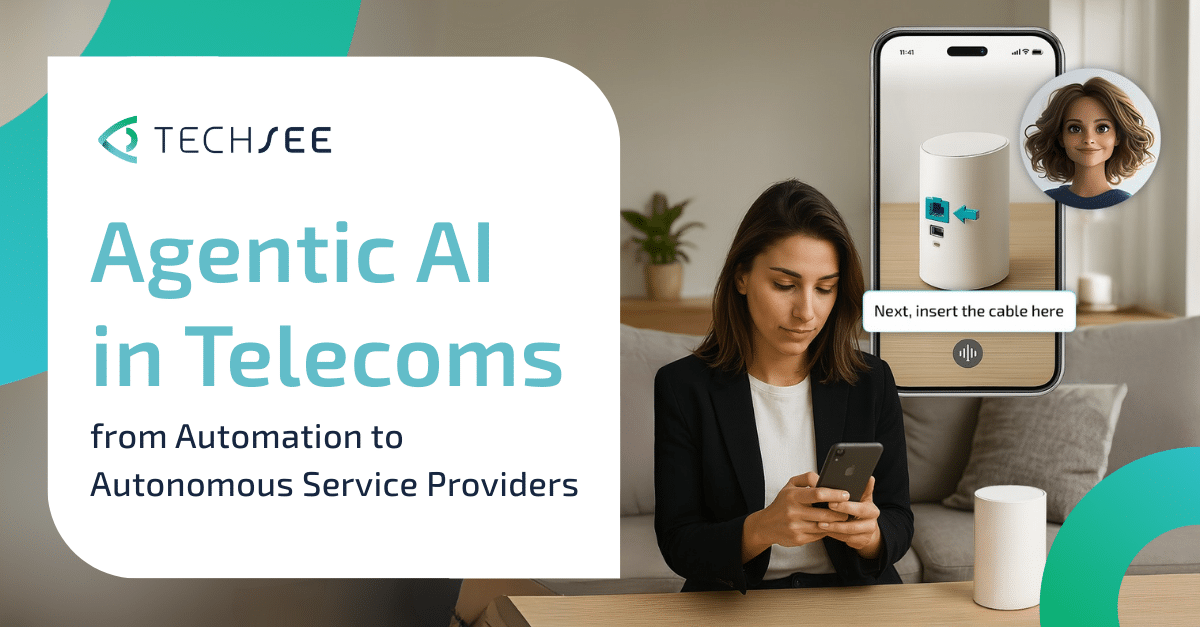Contents
- The Agency Spectrum and Why Telecom Is Ascending It
- Real-World Evidence: Initial Steps Towards Agentic AI
- From Scripts to Context: AI agents in Customer Experience
- Visual Network Diagnostics: Home Connectivity as a Retention Strategy
- Agentic AI Throughout the Value Chain in Telecom
- Establishing Trust Before Handing Over
- The Future Directions for Agentic AI in Telecom
- FAQ
Automation in telecoms has been underway for generations. From robot process automation (RPA) to predictive analysis, to generative AI breaking into the scene, every step has driven operators into doing more with less. And today, another leap entirely is underway – one from “assistance” to real autonomy.
This hop is driven by telecom’s agentic AI – AI agents that are not mere responsive tools but learning, goal-oriented systems able to adapt to their surroundings and act autonomously. For telecom service providers, CSP agentic AI is bridging today’s disjointed, reactive operations and the networks of the future that will proactively self-manage.
The Agency Spectrum and Why Telecom Is Ascending It
AI agency is a spectrum. At one end are low-agency tools like basic chatbots or static rule engines. At the other are AI agents for telecom that can perceive complex environments, plan multi-step actions, and make autonomous decisions that span CX, network operations, and service assurance.
In a telecommunications environment where milliseconds matter, and where OSS/BSS, multi-vendor network layers, and customer touchpoints must work in concert, climbing toward high agency is not optional – it’s a competitive necessity.
Real-World Evidence: Initial Steps Towards Agentic AI
Several telecom operators are already showing what early stages of agentic AI adoption look like:
- Vodafone is deploying agentic AI to boost network performance by adding autonomous “little helpers for engineers” on top of its existing machine learning systems. These AI agents orchestrate actions and automate routine tasks, while Vodafone’s hybrid approach integrates Google Cloud and Microsoft to maintain flexibility and avoid vendor lock-in.
- Verizon is advancing its customer experience by deploying service AI agents that handle personalization and relieve workload for frontline staff. These AI helpers autonomously analyze detailed customer data, think device history, premium perks, or who’s eligible for an upgrade and use that insight to craft bespoke recommendations and solutions in real time. As their CX chief puts it: “From the outset, our strategy has been to go beyond fixing the problem and enhance the experience through proactive, next‑level service.
These examples show a shift from reactive ticket handling to proactive engagement – a hallmark of agentic AI in telecom.
From Scripts to Context: AI agents in Customer Experience
Static chatbots frustrate customers and increase churn risk. AI agents for telecom go beyond scripted flows, using deep natural language capabilities, context awareness, and decision-making autonomy to guide entire customer journeys.
For instance, an end-to-end support can be provided to newly installed broadband customers, such as verifying installation preparedness, offering customized setup procedures, identifying configuration problems in real time, and even initiating OSS/BSS changes automatically.
Visual AI agents go one step further. With live video or uploaded images, they can spot loose cabling, improper device connections, or equipment positioning problems – providing AR-like, step-by-step guidance to resolve them. At this level of guided, visual-first service, it’s particularly important for home connectivity, where retention depends on providing flawless Wi-Fi performance and lightning-fast resolution of problems.
Visual Network Diagnostics: Home Connectivity as a Retention Strategy
Up to 45% of customer churn in wireless service is directly linked to poor connectivity experiences – not due to pricing or plan confusion, but simply because of the failure to provide consistent and reliable service throughout the home. In broadband, more than half of providers exceed the industry’s target churn rate of 3% per year, primarily due to perceived connectivity failures.
One of the biggest churn triggers for telecom providers is poor home connectivity. Agentic AI can directly target this pain point by combining data-driven diagnostics with visual intelligence – without relying on brand-specific hardware solutions.
Imagine a customer reporting slow speeds. Instead of following a rigid scripted call, an AI agent initiates a visual network diagnostic session. It begins by gathering telemetry from the router, mesh nodes, and access points, then overlays that data with live camera input showing device placement or wiring. The AI can interpret this combined view to identify Wi-Fi interference from household appliances, signal dead zones in key living areas, or damaged physical ports. Once the root cause is clear, it can run remote fixes immediately or provide the customer with clear, precise instructions to resolve the issue on their own.
By incorporating that capability into the service process, telecom operators can turn home connectivity from one of their biggest areas of dissatisfaction to one of their key strategic drivers for customer retention – identifying and fixing issues proactively before they affect user experience.
Agentic AI Throughout the Value Chain in Telecom
The prospective for using agentic AI in telecom operations goes much wider than customer service.
- Network Operations: Predictive maintenance, anomaly detection, and automatically identifying root cause are performed end-to-end by AI agents. After-repair verification is automated, and human engineers can then concentrate on novel, complex cases.
- Managed Network Services: Tier 0 incident responders autonomously remediate known issues, escalating only when necessary. AI-driven digital twins simulate changes before deployment, reducing downtime risk.
- Security: AI-powered SASE and network security platforms dynamically optimize policies, quarantine suspicious activity, and deploy new protections in real time.
Establishing Trust Before Handing Over
The path to full autonomy requires trust. Hallucinations, reasoning errors, and unintended actions must be mitigated through strong governance frameworks, human-in-the-loop processes, and robust TRiSM-based controls.
Workforce strategy is equally important. With telecos’ AI agents assuming operational roles, human expertise shifts into training agents, quality control, and overseeing. Telecos who invest in reskilling today will better scale safely.
The Future Directions for Agentic AI in Telecom
Initial adoption must target high-variability, high-value areas:
- Visual-assisted onboarding and troubleshooting for home connectivity.
- Sophisticated, highly contextualized customer interactions.
- Autonomous and predictive network operations.
The winning providers will be those which merge the power to decide on agentic AI with the context and accuracy of visual network diagnostics – making every action data-informed as well as rooted in reality.
FAQ
Q1: What is agentic AI in telecom?
Agentic AI in telecom refers to AI agents that can perceive, plan, and act autonomously across telecom operations – from customer service to network management – with minimal human intervention.
Q2: How do telecom service providers employ AI agents today?
Current uses include enhanced virtual assistants (Vodafone SuperTOBi, Telkomsel Veronika), predictive network monitoring, autonomous incident resolution, and visual troubleshooting for home connectivity issues.
Q3: What is the contribution of telecom operations to AI research?
Visual AI agents utilize camera input and telemetry visualization to resolve and repair issues, guide customers through configurations, and assist field technicians remotely – reducing truck rolls and increasing satisfaction.
Q4: How does agentic AI improve home connectivity?
By integrating network telemetry and visual diagnostics, agentic AI will discover signal interference, misplaced devices, or bad wires and resolve them from afar – enhancing Wi-Fi performance and decreasing churn.
Q5: What are the main risks associated with adopting agentic AI in telecom?
They involve AI error in decisions, hallucinations, and security loopholes. These are countered by governance frameworks, human-in-the-loop control, and systems for managing risk, trust, and security (TRiSM).






